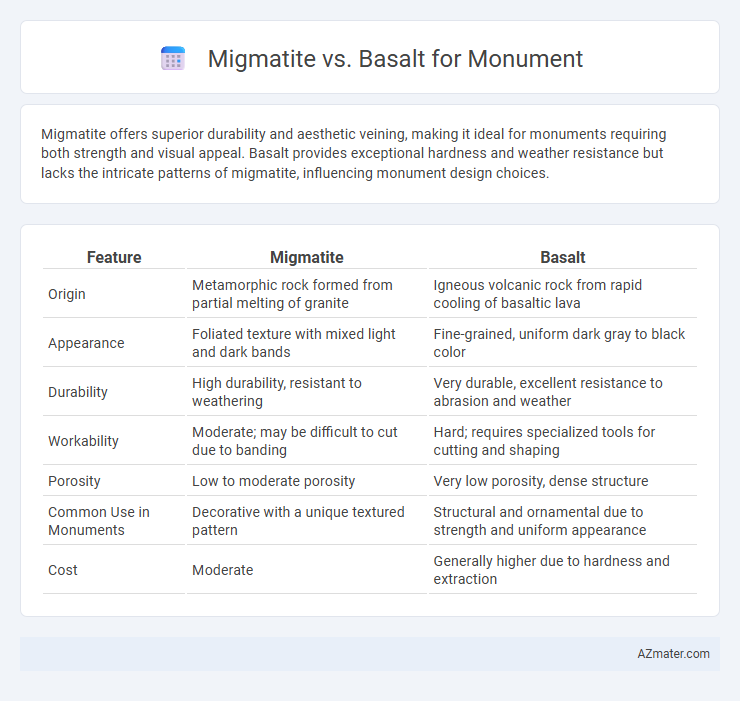Migmatite offers superior durability and aesthetic veining, making it ideal for monuments requiring both strength and visual appeal. Basalt provides exceptional hardness and weather resistance but lacks the intricate patterns of migmatite, influencing monument design choices.
Table of Comparison
| Feature | Migmatite | Basalt |
|---|---|---|
| Origin | Metamorphic rock formed from partial melting of granite | Igneous volcanic rock from rapid cooling of basaltic lava |
| Appearance | Foliated texture with mixed light and dark bands | Fine-grained, uniform dark gray to black color |
| Durability | High durability, resistant to weathering | Very durable, excellent resistance to abrasion and weather |
| Workability | Moderate; may be difficult to cut due to banding | Hard; requires specialized tools for cutting and shaping |
| Porosity | Low to moderate porosity | Very low porosity, dense structure |
| Common Use in Monuments | Decorative with a unique textured pattern | Structural and ornamental due to strength and uniform appearance |
| Cost | Moderate | Generally higher due to hardness and extraction |
Introduction: Migmatite vs Basalt for Monuments
Migmatite, a composite rock featuring both igneous and metamorphic characteristics, offers unique aesthetic textures and high durability ideal for monuments. Basalt, an extrusive igneous rock known for its fine-grained texture and exceptional hardness, provides excellent weather resistance and longevity in monument construction. Comparing structural integrity, visual appeal, and environmental resilience highlights the advantages and considerations of using migmatite versus basalt for enduring memorials.
Geological Origins of Migmatite and Basalt
Migmatite forms through the partial melting of pre-existing rocks during high-grade metamorphism, resulting in a composite structure of both igneous and metamorphic layers. Basalt originates from the rapid cooling of low-viscosity lava at the Earth's surface, primarily composed of fine-grained mafic minerals. The contrasting geological origins influence their durability and aesthetic, making migmatite a complex, textured stone, while basalt offers uniform hardness and dark coloration for monuments.
Physical Properties and Appearance
Migmatite exhibits a banded or streaked appearance with alternating light and dark minerals, providing a visually striking texture ideal for monuments requiring aesthetic appeal. It has high durability and resistance to weathering due to its mixed metamorphic and igneous characteristics, ensuring long-lasting structural integrity. Basalt features a fine-grained, uniform dark gray to black color with excellent hardness and compressive strength, making it suitable for monuments requiring robust physical properties and minimal maintenance.
Durability and Weather Resistance
Migmatite exhibits exceptional durability and weather resistance due to its hybrid composition of metamorphic and igneous rock, making it highly suitable for monuments exposed to harsh environmental conditions. Basalt, while also durable and resistant to weathering, is generally more prone to surface erosion and chemical breakdown over time compared to migmatite. The superior hardness and structural integrity of migmatite ensure long-lasting monument preservation in variable climates.
Workability and Sculpting Potential
Migmatite offers superior workability and sculpting potential compared to basalt due to its mixed metamorphic and igneous composition, which provides a more malleable texture for detailed carving. Basalt, being a dense and fine-grained igneous rock, is significantly harder and more resistant, making intricate sculpting challenging and requiring specialized tools. The relative softness of migmatite allows artisans to achieve finer detail and smoother finishes, making it a preferred choice for monuments requiring elaborate design.
Color and Aesthetic Appeal
Migmatite offers a unique, swirling blend of light and dark minerals, creating a visually striking pattern that enhances the aesthetic appeal of monuments with its natural, variegated color palette. Basalt, characterized by its uniform dark gray to black color, provides a sleek, modern look that conveys strength and durability. The choice between migmatite's complex, artistic texture and basalt's consistent, bold tone impacts the monument's overall visual impression and stylistic expression.
Historical Use in Monument Construction
Migmatite, known for its unique blend of metamorphic and igneous characteristics, has been used historically in monument construction due to its durability and distinctive banded appearance, notably in ancient structures across Scandinavia and parts of Eastern Europe. Basalt, a dense volcanic rock, features prominently in monuments such as the ancient Roman columns and the moai statues of Easter Island, prized for its toughness and resistance to weathering. The choice between migmatite and basalt historically depended on regional availability and the desired aesthetic, with migmatite offering complex patterns and basalt providing uniform dark tones.
Cost and Availability
Migmatite is generally more expensive than basalt due to its rarity and complex formation process, making it less readily available for large-scale monument projects. Basalt, abundant and widely distributed, offers a cost-effective option with consistent supply and durability for monuments. The choice between migmatite and basalt depends largely on budget constraints and local availability, with basalt favored for economical and accessible sourcing.
Environmental Impact and Sustainability
Migmatite, formed through partial melting and recrystallization, offers greater durability and lower permeability compared to basalt, reducing weathering and maintenance needs in monuments. Basalt, a volcanic igneous rock, is abundant and accessible but requires more frequent conservation efforts due to higher porosity and susceptibility to acid rain damage. Selecting migmatite for monuments enhances sustainability by minimizing resource consumption and environmental degradation over the lifespan of the structure.
Choosing the Ideal Stone for Monuments
Migmatite, characterized by its intricate mix of metamorphic and igneous textures, offers exceptional durability and unique aesthetic patterns ideal for monuments requiring long-lasting visual appeal. Basalt, a dense volcanic rock with high compressive strength and weather resistance, excels in monuments exposed to harsh environmental conditions. Selecting between migmatite and basalt depends on the desired balance of artistic expression and structural resilience in monument design.

Infographic: Migmatite vs Basalt for Monument
 azmater.com
azmater.com